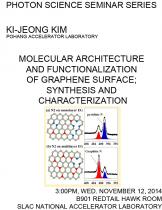Speaker:Ki-jeong Kim, Pohang Accelerator Laboratory
Program Description
Controlling the surface chemical composition and functionalization its modification at the atomic scale are an area of crucial importance in the emerging field of nanotechnology, such as nanofabrication, nanopatterning, selfassembly, nanosensors, drug delivery, pigments, photocatalysis, LEDs, etc.. Here, we synthesized molecule and graphene hybrid system and characterized the surface property. The adsorption site and change of electronic structure due to the adsorption of the molecules are investigated by Scanning Probe Microscopy (SPM) with atomic level resolution. In addition, Photoelectron Spectroscopic (PES) study using synchrotron radiation accelerator with various area of beam energy offers us information of electronic state and chemical binding state in the surface and interface of the hybrid system. Furthermore, bonding type and orientation of the molecule adsorbed on the surfaces of graphene is confirmed by Near Edge X-ray Absorption Fine Structure (NEXAFS). Through this results, we elucidated that each adsorbed molecule has a preferred adsorption geometry. Moreover, we were able to control the band gap of graphene using valence band spectra as we change the species or the amount of the dosing of molecules.





